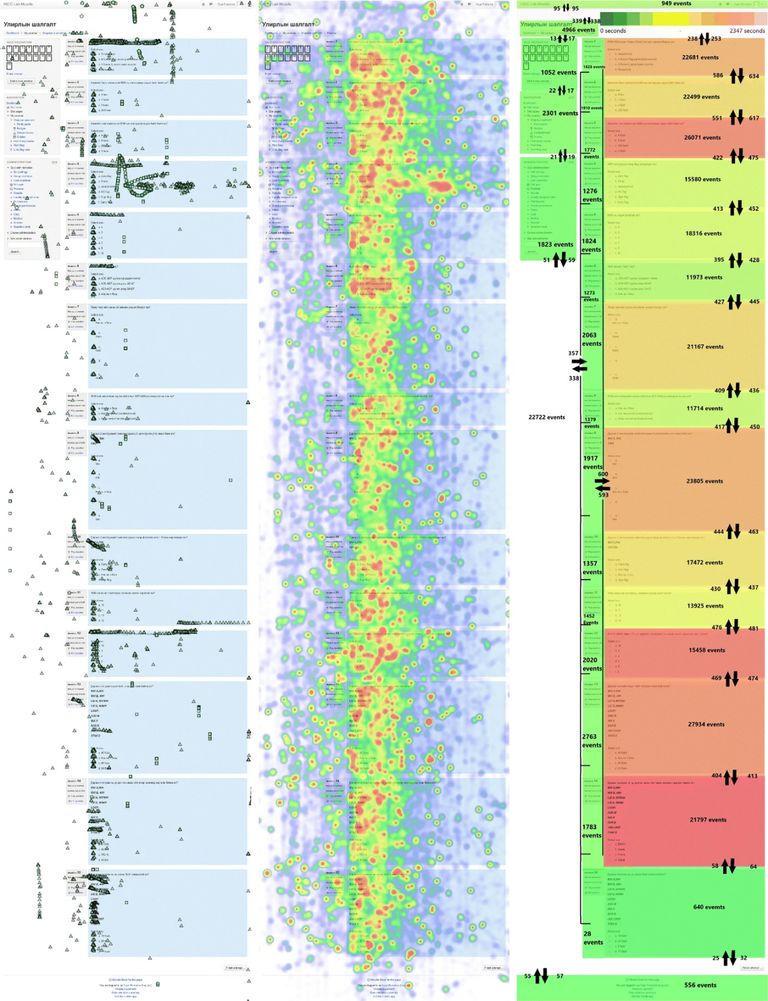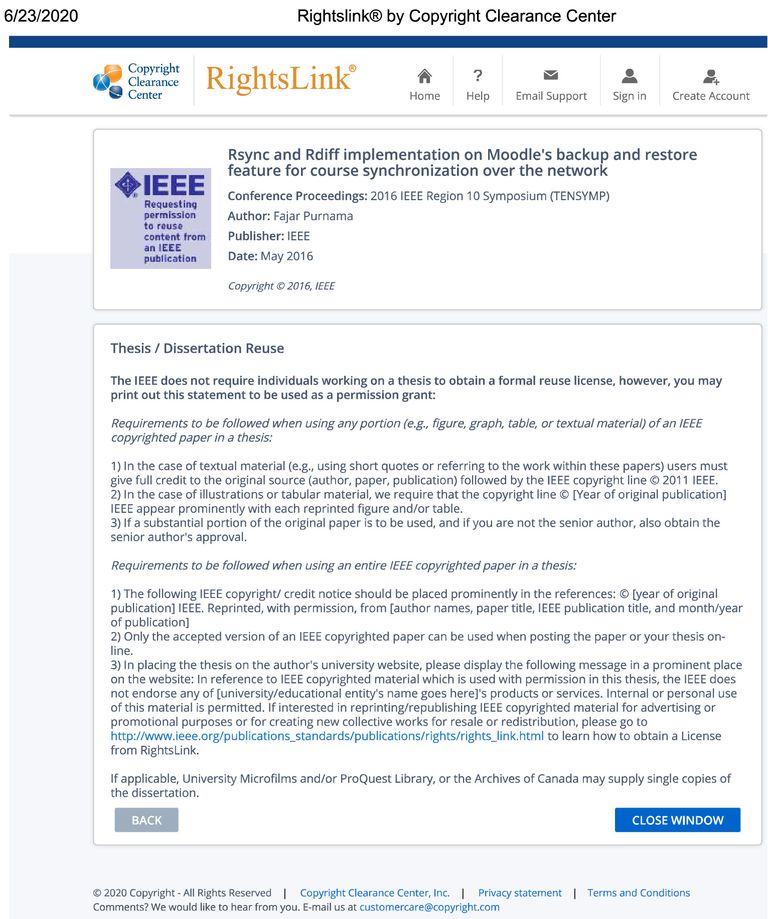5 Conclusion and Future Work
5.1 Conclusion
The author wrote an online mouse tracking application suitable for public implementation and implemented during a quiz session at the Human Interface and Cyber Communication Laboratory, Kumamoto University on the 3rd of January 2019 between approximately 12:00 and 14:30 Japan standard time. The amount of data generated by mouse tracking was investigated during the implementation and found that the cause of huge data generation is the capturing of geometrical data or coordinates of each event. Aside from existing solutions to reduce data, this thesis also implemented and discussed real-time transmission system in mouse tracking data retrieval helps distribute the network's burden across the time domain. The main novelty of this thesis is the select-able geometrical online mouse tracking method where there are possible cases that not all the geometrical data are required. The method allows summarizing of coordinates into areas or deleting the coordinates if they are not necessary. The results showed great reduction in storage and transmission costs. However, the method is lossy because the process is irreversible. Rich mouse tracking data were obtained and in this thesis a new concept of log dept level was discussed with example analysis that include click visualization and activity heatmap which help in identifying the interaction between the students' and the quiz page.
5.2 Future Work
The real-time transmission is not the best solution. A better method is to upgrade the real-time transmission method by integrating smart transmission method where the client can detect the traffic of the network and determine the optimal time for queuing and transmission. Although the select-able geometrical mouse tracking data method works perfectly, there are still problems with execution. If all of the geometrical data are excluded, the most efficient time to transmit the data is only once which is when the user leaves the page. However, the problem lies with the browser where there is currently no way to force the user to wait before the transmission process finishes, leaving potential problem of data loss. The problem for ROI tracking is that it cannot perform smart area determination and labelling. Normally, they are performed by humans. Therefore, one solution is to develop an artificial intelligence for this matter in the future. Finally, this doctoral thesis is only limited to mouse tracking with one type of activity which is examination. There are a various activities such as passage reading, e-commerce, entertainment, Geo-visualization reading, search engine, social media, etc which are open for future work.
Appendix A Data
A.1 Quiz Areas
| **Area** | **x1, x2, y1, y2** | **Area** | **x1, x2, y1, y2** |
| Header | 0, 1920, 0, 64 | Quiz8 Question | 529, 1900, 2453, 2493 |
| Title | 16, 1904, 150, 270 | Quiz8 Answers | 529, 1900, 2494, 2730 |
| Quiz Navigation | 18, 364, 291, 532 | Quiz9 Flag | 384, 528, 2731, 3242 |
| Navigation | 16, 366, 551, 1042 | Quiz9 Question | 529, 1900, 2731, 2831 |
| Administration | 18, 364, 1062, 1693 | Quiz9 Answers | 529, 1900, 2832, 3242 |
| Quiz1 Flag | 384, 528, 291, 570 | Quiz10 Flag | 384, 528, 3243, 3580 |
| Quiz1 Question | 529, 1900, 291, 341 | Quiz10 Question | 529, 1900, 3243, 3343 |
| Quiz1 Answers | 529, 1900, 342, 570 | Quiz10 Answers | 529, 1900, 3341, 3580 |
| Quiz2 Flag | 384, 528, 571, 852 | Quiz11 Flag | 384, 528, 3581, 3856 |
| Quiz2 Question | 529, 1900, 571, 621 | Quiz11 Question | 529, 1900, 3581, 3631 |
| Quiz2 Answers | 529, 1900, 622, 852 | Quiz11 Answers | 529, 1900, 3632, 3856 |
| Quiz3 Flag | 384, 528, 853, 1133 | Quiz12 Flag | 384, 528, 3857, 4169 |
| Quiz3 Question | 529, 1900, 853, 903 | Quiz12 Question | 529, 1900, 3857, 3907 |
| Quiz3 Answers | 529, 1900, 904, 1133 | Quiz12 Answers | 529, 1900, 3908, 4169 |
| Quiz4 Flag | 384, 528, 1134, 1441 | Quiz13 Flag | 84, 528, 4170, 4746 |
| Quiz4 Question | 529, 1900, 1134, 1184 | Quiz13 Question | 529, 1900, 4170, 4520 |
| Quiz4 Answers | 529, 1900, 1185, 1441 | Quiz13 Answers | 529, 1900, 4521, 4746 |
| Quiz5 Flag | 384, 528, 1442, 1748 | Quiz14 Flag | 384, 528, 4747, 5295 |
| Quiz5 Question | 529, 1900, 1442, 1492 | Quiz14 Question | 529, 1900, 4747, 5097 |
| Quiz5 Answers | 529, 1900, 1493, 1748 | Quiz14 Answers | 529, 1900, 5098, 5295 |
| Quiz6 Flag | 384, 528, 1749, 2027 | Quiz15 Flag | 384, 528, 5296, 5842 |
| Quiz6 Question | 529, 1900, 1749, 1799 | Quiz15 Question | 529, 1900, 5296, 5646 |
| Quiz6 Answers | 529, 1900, 1800, 2027 | Quiz15 Answers | 529, 1900, 5647, 5842 |
| Quiz7 Flag | 384, 528, 2028, 2452 | Footer | 0, 1920, 5939, 6116 |
| Quiz8 Flag | 384, 528, 2453, 2730 | Blank Areas | except listed here |
A.2 Full Quiz Page Heatmap

Figure A.1 Visualization of mouse tracking data. Default mouse tracking data can visualize exact points of location, the left image is click visualization and the middle image is a heatmap based on the duration the mouse cursor stays on each point, while ROI tracking can only visualize defined areas and show flows between areas shown on the right image.
Appendix B Copyrights
Below are the publications reused in this thesis that does not require copyright clearance:
- Using real-time online preprocessed mouse tracking for lower storage and transmission costs" (Purnama and Usagawa, 2020).
- Demonstration on Extending The Pageview Feature to Page Section Based: Towards Identifying Reading Patterns of Users (Purnama, Fungai, and Usagawa, 2016).
Below are the publications reused in this thesis that requires copyright clearance and obtained:
- Rsync and Rdiff implementation on Moodle's backup and restore feature for course synchronization over the network (Purnama, Usagawa, Ijtihadie, et al., 2016).
- Incremental Synchronization Implementation on Survey using Hand Carry Server Raspberry Pi (Purnama, 2017).
- Implementation of real-time online mouse tracking on overseas quiz session" (Purnama et al., 2020b).

https://s100.copyright.com/CustomerAdmin/PLF.jsp?ref=d6af378c-4d45-49da-90cf-5ce0e54d2473
Material details:
- Original author's name: Fajar Purnama, Tsuyoshi Usagawa
- Document title: Incremental Synchronization Implementation on Survey using Hand Carry Server Raspberry Pi
- Book or journal title: Technical Report, vol. 117, no. 65, ET2017-4, pp. 21-24, year 2017, month 5.
- Portion: Figure 5
Permission No.: 20GB0052
IEICE hereby grant permission for the use of the material requested above on condition that their requirements are as follows:
- Indication of source (e.g., author's name, document title, name of journal, volume/issue/page number, publication date, etc.)
- Indication of copyright (e.g. "Copyright (c)2016 IEICE")
Reference
- Azzuhri, Abdul Adhim et al. (2018). “A Creative, Innovative, and Solutive Transportation for Indonesia with Its Setbacks and How to Tackle Them: A Case Study of the Phenomenal GOJEK”. In: Review of Integrative Business and Economics Research 7, pp. 59–67. URL: http://buscompress.com/uploads/3/4/9/8/34980536/riber_7-s1_sp_h17-051_59-67.pdf
- Bluehost (2016). Web Analytics for Beginners - Presented by Bluehost. Youtube. URL: https://youtu.be/PnVZ7_OA7Qo.
- Dentzel, Zaryn (2013). “How the internet has changed everyday life”. In: BBVA OpenMind:" Ch@nge. URL: https://www.bbvaopenmind.com/en/articles/internet-changed-everyday-life/
- Hsu, Ting-Chia, Shao-Chen Chang, and Nan-Cen Liu (2018). “Peer Assessment of Webpage Design: Behavioral Sequential Analysis Based on Eye Tracking Evidence”. In: Journal of Educational Technology & Society 21.2, pp. 305–321. URL: www.jstor.org/stable/26388409
- Huang, Jeff, Ryen W White, and Susan Dumais (2011). “No clicks, no problem: using cursor movements to understand and improve search”. In: Proceedings of the SIGCHI conference on human factors in computing systems. ACM, pp. 1225–1234. DOI: 10.1145/1978942.1979125.
- IEICE (2015). IEICE Provisions on Copyright. IEICE. URL: https://www.ieice.org/eng/copyright/files/copyright.pdf.
- Leiva, Luis A and Jeff Huang (2015). “Building a better mousetrap: Compressing mouse cursor activity for web analytics”. In: Information Processing & Management 51.2, pp. 114–129. DOI: 10.1016/j.ipm.2014.10.005.
- Linawati, Linawati, NMAE Dewi Wirastuti, and Gede Sukadarmika (2017). “Survey on LMS Moodle for Adaptive Online Learning Design”. In: Journal of Electrical, Electronics and Informatics 1.1, pp. 11–16. DOI: 10.24843/JEEI.2017.v01.i01.p03.
- Martín-Albo, Daniel et al. (2016). “Strokes of insight: User intent detection and kinematic compression of mouse cursor trails”. In: Information Processing & Management 52.6, pp. 989–1003. DOI: 10.1016/j.ipm.2016.04.005.
- Ookla (2020). Speedtest Global Index. Ookla, LLC. URL: https://www.speedtest.net/global-index.
- Paturusi, Sary DE, Yoshifumi Chisaki, and Tsuyoshi Usagawa (2012). “Development and Evaluation of the Blended Learning Courses at Sam Ratulangi University in Indonesia.” In: International Journal of e-Education, e-Business, e-Management and e-Learning 2.3, p. 242. URL: http://www.ijeeee.org/Papers/118-CZ02027.pdf
- Pixley, Tom et al. (2000). “Document object model (DOM) level 2 events specification”. In: W3C recommendation, November. URL: https://www.w3.org/TR/2000/REC-DOM-Level-2-Events-20001113/
- PrivacyPolicies.com (2020). Privacy Policies are required by law. PrivacyPolicies.com. URL: https://www.privacypolicies.com.
- Purnama, Fajar (2017). “Portable and Synchronized Distributed Learning Management System in Severe Networked Regions”. MA thesis. Japan: Kumamoto University. URL: https://0fajarpurnama0.github.io/masters/2020/09/05/master-thesis-fajar-purnama
- Purnama, Fajar (2019). 0fajarpurnama0/Real-Time-Online-Mouse-Tracking-Animation. Github. DOI: 10.5281/zenodo.2589338. URL: https://github.com/0fajarpurnama0/RealTime-Online-Mouse-Tracking-Animation.
- Purnama, Fajar, Alvin Fungai, and Tsuyoshi Usagawa (2016). “Demonstration on Extending The Pageview Feature to Page Section Based: Towards Identifying Reading Patterns of Users”. In: 7th International Conference on Science and Engineering. Yangon Technological University, pp. 304–307. URL: https://0fajarpurnama0.github.io/masters/2020/05/25/extending-the-pageview-feature-to-page-section-based
- PURNAMA, Fajar and Tsuyoshi USAGAWA (2017). “Incremental Synchronization Implementation on Survey using Hand Carry Server Raspberry Pi”. In: IEICE technical report 117.65, pp. 21–24. URL: https://0fajarpurnama0.github.io/masters/2020/05/29/rsync-rdiff-moodle-backup-restore
- Purnama, Fajar and Tsuyoshi Usagawa (2020). “Using real-time online preprocessed mouse tracking for lower storage and transmission costs”. In: Journal of Big Data 7, pp. 1–22. DOI: 10.1186/s40537-020-00304-x.
- Purnama, Fajar, Tsuyoshi Usagawa, Royyana M Ijtihadie, et al. (2016). “Rsync and Rdiff implementation on Moodle’s backup and restore feature for course synchronization over the network”. In: 2016 IEEE Region 10 Symposium (TENSYMP). IEEE, pp. 24–29. DOI: 10.1109/TENCONSpring.2016.7519372.
- Purnama, Fajar et al. (2016). “Introductory Work on Section Based Page View of Web Contents: Towards The Idea of How a Page is Viewed”. In: 11th International Student Conference on Advanced Science and Technology (ICAST). Kumamoto University, pp. 9–11. URL: https://0fajarpurnama0.github.io/masters/2020/05/24/introductory-section-based-page-view
- Purnama, Fajar et al. (2017). “Hand Carry Data Collecting Through Questionnaire and Quiz Alike Using Mini-computer Raspberry Pi”. In: Proceedings of the International Mobile Learning Festival 2017: Mobile Learning, Emerging Learning Design & Learning 2.0, pp. 18–32. URL: https://0fajarpurnama0.github.io/masters/2020/05/30/hand-carry-server-survey
- Purnama, Fajar et al. (2020a). Data for: Implementation of Real-Time Online Mouse Tracking Case Study in a Small Online Quiz. Mendeley Data, v3. DOI: https://doi.org/10.17632/vznyfcx9xk.4.
- Purnama, Fajar et al (2020b). “Implementation of Real-Time Online Mouse Tracking on Overseas Quiz Session From Server Administrator Point of View”. In: Education and Information Technologies (forthcoming), p. 36. DOI: 10.1007/s10639-020-10141-3.
- Rheem, Hansol, Vipin Verma, and D Vaughn Becker (2018). “Use of Mouse-tracking Method to Measure Cognitive Load”. In: Proceedings of the Human Factors and Ergonomics Society Annual Meeting. Vol. 62. SAGE Publications Sage CA: Los Angeles, CA, pp. 1982–1986. DOI: 10.1177/1541931218621449.
- Rodrigues, Manuel et al. (2013). “Keystrokes and clicks: Measuring stress on e-learning students”. In: Management Intelligent Systems. Springer, pp. 119–126. DOI: 10.1007/978-3-319-00569-0_15.
- u, u-double (2020). SPEED-BATTLE statistics and browser comparison: Windows NT 10.0. u-double-u. URL: http://www.speed-battle.com/statistics_e.php.
- UNESCO (2020). COVID-19 Educational Disruption and Response. UNESCO. URL: https://en.unesco.org/covid19/educationresponse.
- Wood, Lauren et al. (1998). “Document object model (dom) level 1 specification”. In: W3C recommendation 1. URL: https://www.w3.org/TR/1998/REC-DOM-Level-1-19981001/